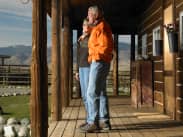Retirement looks a lot different today than it did nearly 100 years ago when Social Security first came into being.
Life expectancy at birth is now 77, 15 years later than in 1935 when the U.S. adopted 65 as the official retirement age. The prevalence of centenarians — people over the age of 100 — in our population has doubled.
Read: Want to live to 100? Here’s what the latest longevity research says
Many people are choosing to spend those extra years in the workforce. Roughly one in five adults aged 65 and older is working — twice as many as in the 1980s. Over the next decade, the number of working Americans 75 or older is expected to nearly double.
Our century-old definition of retirement is due for an update. Many older Americans have already decided that this binary mode — they’re either working or they’re not — is not how they’d like to spend their golden years. It’s time for public policy to catch up with them — and make it easier for people to work as they age, if they so choose.
Read: These workers may have found the secret to a fulfilling retirement
People’s motivations for staying employed into their 60s, 70s and beyond vary. Some continue working out of financial necessity. Perhaps their savings and Social Security aren’t enough to allow them to pursue the retirement lifestyle they’d like. Others simply don’t want to give up a well-paying gig, as the past few years before retirement are often the most lucrative and satisfying in workers’ careers.
According to the most recent American Working Conditions Survey from RAND, more than two-thirds of workers aged 50 or older say they feel useful and satisfied with their careers, a higher rate than for those between 35 and 49.
Read MarketWatch’s The View From Unretirement column
Still others may crave the health benefits that engaging in productive work can deliver. Research shows that older Americans who work experience lower rates of depression and cognitive decline than full retirees. And others may be interested in down-shifting from a full-time job to a position that leaves room for other activities and interests.
The rise of remote and gig work has made a more flexible, individually tailored transition to “retirement” possible.
Read: Warning: Jobs advertised as ‘remote’ don’t always stay that way
Unfortunately, our legacy employer-based system of benefits does not mesh well with the way that older Americans wish to work and engage with their communities today. That needs to change.
Americans should have access to a range of portable benefit plans they can keep regardless of their situation — whether they’re on hiatus from work, switching employers or pursuing part-time jobs. Such plans would allow companies to be more flexible about the types of positions they offer — a change that could meet “unretired” people exactly where they are and enable businesses to compete for their talent. This approach could also help companies retain aging full-time workers in part-time roles.
Individual Coverage Health Reimbursement Arrangements (ICHRAS) are one example of these kinds of portable health benefits. These funds enable companies to reimburse various healthcare expenses for employees tax-free — including Medicare premiums. Enrollees retain access to their accounts if they switch jobs or stop working.
Lawmakers should eliminate rules that prohibit gig workers — who are legally considered independent contractors — from accessing most company benefits, including ICHRAs. Allowing businesses to provide benefits for people who prefer the flexibility granted by being independent contractors would create more realistic jobs for seniors and boost overall economic growth.
Read: What does it mean to live to 100?
There is a similar benefit called a Retiree HRA, or RHRA, that employers may provide to their retiring workers to spend on Medicare coverage. Again, here’s an opportunity to leverage HRAs to create more flexibility in supporting partial retirement.
These reforms would enable us to reframe expectations around retirement planning. Social Security’s “full retirement age” is currently 67. But it’s been shown that quitting work entirely at that age is often detrimental to many people’s financial stability or health.
If seniors have access to fulfilling jobs with benefits they can take with them, then they may be able to treat work as something they can do as much as they want and for as long as they want.
Americans are living nearly as long as they ever have. It’s time to update last century’s definition of retirement to reflect the reality of work and life today.
Noah Lang is co-founder and chief executive of Stride Health and an Aspen Institute Fellow.






